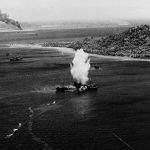Ralph Eugene Meatyard, a photographer whose work remains enigmatic and deeply influential, emerged during a transformative period in American photography. Born on May 15, 1925, in Normal, Illinois, Meatyard’s journey unfolded against the backdrop of post-war America, and his unique approach to photography would later mark him as a key figure in the exploration of the medium’s expressive and symbolic potential.
Growing up in Lexington, Kentucky, Meatyard’s early years were shaped by his fascination with literature and philosophy. He attended Williams College, where he studied philosophy, and later pursued a career as an optician. It was during this time that Meatyard’s interest in photography began to take root. In the early 1950s, he acquired a camera and joined the Lexington Camera Club, a pivotal moment that set the stage for his distinctive contribution to the world of photography.
Lens into the Unseen
Meatyard’s photography was marked by an experimental and avant-garde spirit that defied traditional conventions. In the late 1950s and throughout the 1960s, he began to develop a unique approach that went beyond mere documentation. His lens delved into the unseen, capturing a world that extended beyond the visible surface.
Central to Meatyard’s experimental vision was his use of blurred images, multiple exposures, and distorted perspectives. These techniques, often achieved through intentional camera movement and unconventional darkroom processes, created an ethereal and dreamlike quality in his photographs. The deliberate blurring of subjects added layers of ambiguity, inviting viewers to engage with the images on a more introspective and interpretive level.
Meatyard’s iconic series “The Family Album of Lucybelle Crater” (1974), featuring his wife Madelyn as Lucybelle, exemplifies his experimental and surreal style. The series, characterized by haunting and enigmatic portraits in various settings, challenges conventional notions of family photography. Meatyard used masks, dolls, and props to create a narrative that transcended the ordinary, inviting viewers into a realm where reality and fiction coexist.
The Symbolism of Play and Performance
A recurring theme in Meatyard’s work was the use of masks and theatrical elements. Masks, often handmade by the artist himself, became a symbolic motif that added layers of complexity to his photographs. The use of masks allowed Meatyard to explore themes of identity, transformation, and the intersection between reality and imagination.
In “The Family Album” series, the masks worn by his subjects contribute to the uncanny and surreal atmosphere. The deliberate ambiguity introduced by the masks challenges viewers to question the authenticity of the portrayed scenes, blurring the boundaries between the staged and the authentic. Meatyard’s incorporation of play and performance in his photography reflected his fascination with the psychological and existential aspects of human experience.
The notion of play extended beyond the use of masks; it permeated Meatyard’s approach to photography itself. His willingness to embrace experimentation and chance echoes the spirit of play, allowing unexpected elements to shape the final image. This willingness to explore the unknown and the unconventional positioned Meatyard as a trailblazer in expanding the possibilities of photography as an expressive medium.
Ralph Eugene Meatyard’s Enduring Impact
Ralph Eugene Meatyard’s life was tragically cut short when he passed away on May 7, 1972, at the age of 46. Despite the brevity of his career, his impact on the world of photography has endured. Meatyard’s legacy lies not only in the haunting and evocative images he created but also in the trail he blazed for future generations of photographers.
His unconventional and experimental approach paved the way for a new understanding of photography as a medium for artistic expression and exploration. Meatyard’s influence can be seen in the work of subsequent photographers who embraced a more subjective, interpretive, and conceptual approach to their craft.
Today, his photographs are held in esteemed collections, and retrospectives of his work have been featured in major institutions, including the International Center of Photography in New York and the San Francisco Museum of Modern Art. Meatyard’s legacy continues to captivate and inspire those who seek to explore the depths of photography as a form of artistic expression beyond the confines of traditional representation. The enigma of Ralph Eugene Meatyard lives on in the timeless and evocative images that invite viewers to step into a world where reality and imagination converge.


